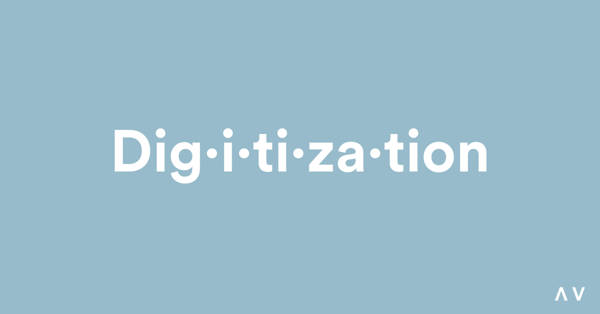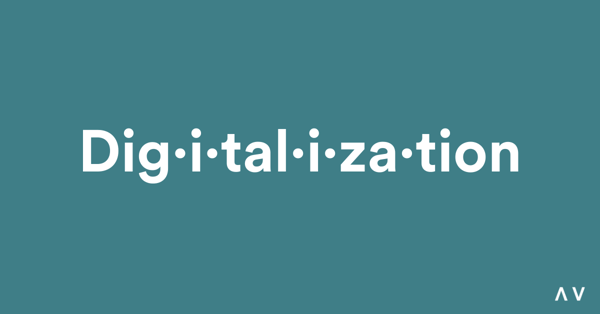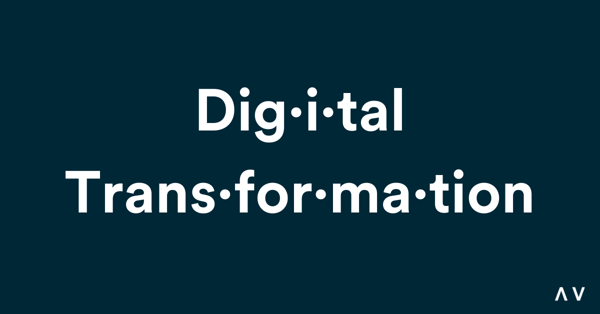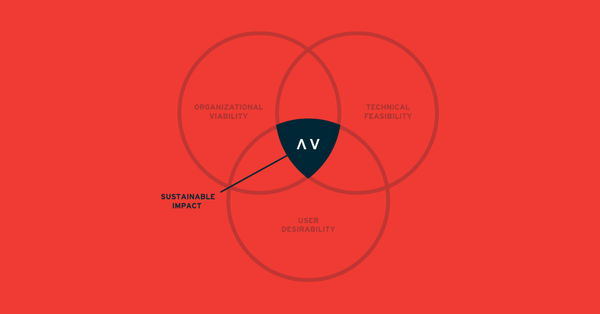Digital Transformation | digitalization | digitization
Digitization, digitalization, digital transformation.
(Say that three times fast.)
Alliteration aside, despite how often these terms are used interchangeably, they each have a distinct meaning — and an impact on your business. Below, we’ll define each and talk through how they all drive impact for your organization.
What We'll Cover:
1. The definitions of digitization, digitalization and digital transformation, plus the differences between them.
2. How all three drive value for you and your organization.
3. The Aviturian approach for each initiative.
Adapting from Analog: Digitization Definition

When you transcribe a sticky note on your desk to a digital version on your desktop, that’s digitization. As defined by Gartner, “digitization is the process of changing from analog to digital form.”
“Digitization is the process of changing from analog to digital form, also known as digital enablement. Said another way, digitization takes an analog process and changes it to a digital form without any different-in-kind changes to the process itself.” (Gartner)
The value in digitization comes from the data you create by adapting analog or physical information to a digital format.
Think of it like this: that physical sticky note only exists on your desk, but when you create a digital version, it now exists as data on your computer — data that’s more easily stored, found, and leveraged.
Here are a few more real-world examples:
- Moving your handwritten notes from a notebook to a word application on your computer
- Using a digital calendar to keep track of your meetings and events instead of a physical planner
- Scanning important documents and saving them to your computer’s hard drive
Digitization is one of the first steps in a digitalization project (or a full digital transformation).
Put Your Data to Work: Digitalization Definition

Digitalization sounds a lot like digitization, and that’s one of the reasons the two are often conflated. So, what’s the difference?
Where digitization means converting the physical to digital, digitalization takes it a step further. Simply put, digitalization means using that data to improve your workflow or business processes.
“Digitalization is the use of digital technologies to change a business model and provide new revenue and value-producing opportunities; it is the process of moving to a digital business.” (Gartner)
Digitalization introduces technology (leveraging all that data you just generated) to improve a process, workflow, or provide new opportunities.
Let’s return to the sticky note metaphor. After moving your sticky note from your desk to your desktop, you decide you want other people within your business to have access to that same information on the sticky note — without having to ask you to send it to them.
So, looking to improve your team’s workflow and remove an unintentional information silo, you move the sticky note’s contents from your digital desktop to a shared document or tool your team has direct access to.
That is an example of digitalization — you’ve successfully identified a way to use technology to add value to your business by improving process to be more efficient, cost-effective, and ultimately, profitable.
Here are a few more real-world examples:
- Converting the notes you took from a Word doc on your computer to a shared Google Doc stored in the cloud
- Using a team-based calendar to view important dates and events across your organization
- Saving those scanned, important documents in a cloud-based, collaborative workspace such as OneDrive, Google Drive or Dropbox
Step 1: Digitize your data. Step 2: Apply technology to improve process. Step 3…
Rapid Innovation: Digital Transformation Definition

So far, you’ve converted your sticky note from a physical piece of paper sticking to your desk to a digital note on your desktop, then moved that information into a collaborative tool you share with your team.
But what if that tool analyzed the data you provided and generated valuable insights as a result? And what if it did it in real-time, notifying you and your team with those insights when you needed them most?
And, finally, what if it integrated seamlessly with all of your other technology to create a holistic view of all the moving parts of your business?
Those are just a few examples of digital transformation.
“Digital transformation can refer to anything from IT modernization (for example, cloud computing), to digital optimization, to the invention of new digital business models.” (Gartner)
Digital transformation is broader than both digitization and digitalization, because it can encompass both and so much more.
It’s mapping your technology strategy, taking into account the tools you use, the processes you’ve established, automating wherever possible and providing the insights you need — whenever and wherever you need them.
You can digitize information, and you can conduct digitalization projects, but a digital transformation transforms your entire business through technology. It’s as simple as that.
How Digital Drives Business Value
What’s the value of a digitalization project or a digital transformation?
“When digital transformation is done right, it’s like a caterpillar turning into a butterfly.” (George Westerman, MIT principal research scientist and author of Leading Digital: Turning Technology Into Business Transformation)
Let’s review a few real-world examples of digitalization and digital transformation initiatives and how they drove operational efficiencies or produced opportunities for organizational growth.
Aim High
The Air Force Recruiting Services (AFRS) came to Aviture needing an avenue to engage a wider audience and attract non-traditional recruits.
While the initial ask was for three separate applications, the Aviture team found synergies within the data that led to our transformative solution: a single public-facing application that’s part recruitment tool, part career guide, and part social network — the Aim High app, a “sister” app to AirForce.com.
Today, the feature-rich mobile application effectively educates the 4.4 million eligible recruits on the career opportunities the Air Force offers. So effective, in fact, that within the first 30 days the app was live to our initial distribution list of 25 users, we garnered more than 250 downloads.
Learn more in our case study.
Carson Group
Carson Group challenged the Aviture team with building a “single pane of glass” client experience that increased accessibility to valuable data, encouraged advisor engagement and unified disparate systems into one view.
Our solution was to unlock Carson Group’s existing data to inform the development of a scalable, unified client-first solution.
As a result, the revamped client experience platform saw a massive increase in average adoption rate with users; climbing from 10-13% to an impressive 50-75%.
Learn more in our case study.
Guardian
The Department of Defense came to Aviture with the need to consolidate multiple data platforms and provide real-time decision support for their drone mission management.
Our solution included the consolidating multiple data platforms and using commercial product development strategies to create an intuitive and responsive interface.
The outcome? Higher success rates for missions abroad, expanded RPA uses, and countless lives protected and saved in the U.S. In fact, the Guardian solution has been used in rescue efforts for Hurricane Harvey and the California wildfires and to provide security for the Boston Marathon and the Super Bowl.
Learn more in our case study.
“Worldwide spending on the technologies and services that enable the digital transformation (DX) of business practices, products, and organizations is forecast to reach $2.3 trillion in 2023.” (International Data Corporation)
The Aviturian Approach
Whether your business is in need of digitization, digitalization or a full digital transformation, at Aviture, we always take an investigative, collaborative approach to reach what we call sustainable impact

The key to sustainable impact is alignment of organizational viability (Is the solution viable within the organization? Will it provide value?), technical feasibility (Is the solution technically feasible?), and user desirability (Is the solution desirable, intuitive, and seamless across all users?).
Aviturians assess potential solutions through the lens of these three perspectives to ensure sustainable impact for your business.
Possibilities Unlocked
Let’s review what we’ve covered:
- Digitization means converting analog assets into a digital format.
- Digitalization introduces technology to improve a process, workflow, or provide new opportunities.
- A digital transformation transforms your business by identifying opportunities to digitize data, digitalize processes, and connect both in order to build a seamless working environment.
- Investing in any of the above initiatives can improve operational efficiencies or produce opportunities for organizational growth.
And say goodbye to sticky notes.


%20(8).png)

